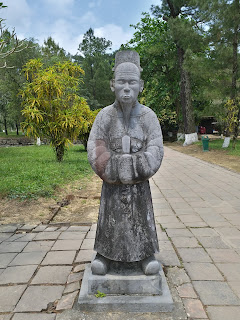
The difference between today and twenty years ago is great; much work had been undertaken to restore the grounds and buildings but even more is required. I was almost disappointed at the current state versus the previous bucolic setting with overgrowth and plants gone wild. It used to be truly a ruin while now it's good to see the pavilions and structures being set to right but the restorers have clearly not yet turned to the landscape. Grass is mowed and trees are being cared for, but it isn't what I think it should be. Gardens still lay fallow or sparsely planted.
If Khai Dinh's tomb is spectacular, Minh Mang's tomb is poetic. Minh Mang was known for uniting the kingdom of Dai Nam and bringing about administrative reform, and for being an austere, orthodox Confucian (insomuch as an emperor can practice piety). His tomb was designed to be tranquil and harmonious with the natural environment.

Within the walls of the sprawling complex are lakes, streams, pavilions, meditation areas, and the typical temples, towers, and palace. The buildings are symmetrically arranged along a 700 metre axis, the "Than Dao" line, which runs from the Dai Hong gate to the foot of the emperor's grave. The topography ressembles a person lying on the ground with his head pillowed on Kim Phung mountain and his legs extending toward the Perfume River. The two sides of Trung Minh resemble extended arms.

Dai Hong Mon, the main entry gate to the tomb, is with decorated with motifs such as carp turning into dragons and then dragons rolling into clouds. It was opened only once to bring the emperor's coffin to the tomb and now remains firmly and finally shut. Visitors entering the tomb complex must utilize two side gates - Ta Hong Mon (left gate) and Huu Hong Mon (right gate). Behind Dai Hong Mon is Bai Dinh (salutation courtyard), paved with bricks from Bat Trang, an area well known for ceramics. Both sides of the courtyard are lined with carved stone mandarins, soldiers, elephants and horses. At the end of the yard is Bi Dinh (stele house), which contains a memorial stone stele inscribed with the Minh Mang's biography and merits, written by his successor, Thieu Tri.

Dai Hong Mon is closed forever, having performed its service.





Past the steel house, the Hien Duc (main gate of the temple area) is located within a square wall that symbolizes the earth, in accordance with the geomancy properties of circular heaven and square earth. Beyond is Sung An palace, dedicated to the emperor and his empress, and flanked by Ta Huu Phoi Dien (front left and right temples) and Ta Huu Tung Phong (back left and right houses).

Hoang Trach gate is the last structure of the temple area, opening to landscape. Seventeen "Thanh" stone steps lead down to a lake surrounded by hills with green trees set against an open sky. Three bridges, Ta Phu (left), Trung Dao (middle) and Huu Dat (right) cross over Trung Minh lake to Minh Lau (bright pavilion) where the emperor often sat to enjoy the pleasant breeze and moonlight in his lifetime. Two obelisks flank the pavilion, on Binh Son and Thanh Son hills, representing Minh Mang's virtues and merits.
Tan Nguyet lake is shaped in a half-moon to represent an endless world. The lake functions as the Yin element protecting the Yang one, Buu Thanh, a symbol of sun. Thong Minh Chinh Truc bridge crosses the lake, leading to 33 steps up Khai Trach mount and surrounded by a circular wall. This circle is the center of several concentric circles created by Tan Nguyet lake, La Thanh surrounding wall, and mountains, representing the Emperor's desire to be the holder of the earth and universe.

I appreciated that one of the most powerful emperors of Dai Nam chose a relatively simple and humble resting place; it is simply a mound of earth.
While the governing axis of the Than Dao controls the layout symmetry on plan, the "in section" experience of moving through the complex provides changes in the topography that break the symmetry. Throughout the landscape, you are climbing or descending, either on axis or meandering through the landscape.

Sadly, many of the smaller buildings and pavilions were destroyed by war, but around 600 panels with carved poems remain, in Bi Dinh (Stele pavilion), Hien Duc gate, Sung An temple and Minh Lau pavilion. These stand as a record and reminder to future generations of the vast knowledge, understanding, beliefs and wishes of Minh Mang's generation.









Comments